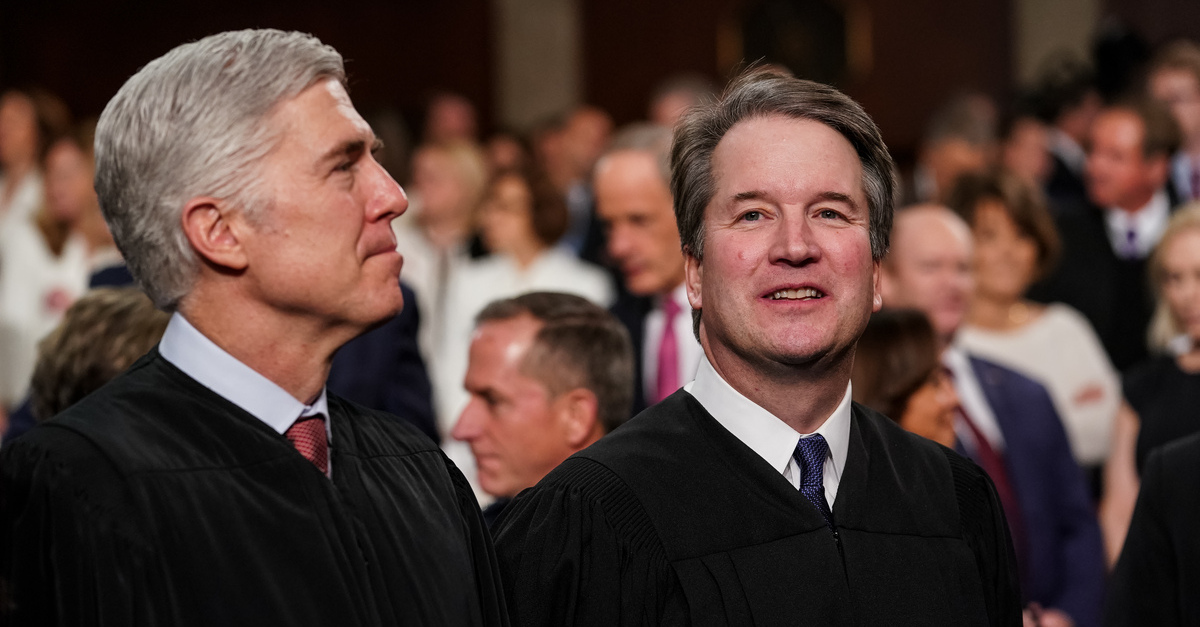
The Atlantic just released a detailed report about what was going behind the scenes at the Supreme Court of the United States in the immediate aftermath of Justice Brett Kavanaugh’s contentious nomination battle.
The story told is of a man shunned by his neighbors and anxious about re-entering the upper-crust polite society. At the same time, his newfound SCOTUS coworkers were keen to welcome him.
Confirmation theater, it seems, reads to justices of the Supreme Court as something more like joining one of the most elite fraternities in the land. And whether Democrat or Republican-nominated, the justices reportedly tend to agree the process is exhausting. So, with Kavanaugh in particular, most of the court lent an outreached hand. That was exemplified by centrist Justice Elena Kagan and right-wing Justice Clarence Thomas, both of whom sought out the then-newly minted justice as a potential ally.
Journalist McKay Coppins reports:
Kagan, an Obama appointee known inside the Court as a deft strategic operator, was quick to make a move. Sensing that Kavanaugh, in this vulnerable moment, might welcome allies wherever he could find them, she launched a quiet charm offensive. While he was still moving into his chambers, Kagan stopped by and offered to host a dinner party in his honor at her Washington apartment. They were seen together frequently—whispering and laughing during oral arguments or talking baseball over lunch in the justices’ private dining hall, where she liked to joke that their conversation was a reprieve from the Shakespearean forays favored by Kavanaugh’s predecessor, Anthony Kennedy. “She saw him as up for grabs,” said one person with knowledge of the Court’s internal dynamics.
The utility of Kagan’s welcoming embrace was reportedly not lost on at least some of the court’s liberals. While Justice Stephen Breyer remained publicly mum, Justice Sonia Sotomayor got the memo and responded to widespread Democratic Party base anger by moving on and noting: “This is our work family, and it’s just as important as our personal family.” Ditto for the late justice Ruth Bader Ginsburg, who rankled progressives, Democrats, leftists and #MeToo supporters by directly praising Kavanaugh as both “very decent and very smart.”
Coppins writes that the “women on the bench followed Kagan’s lead” in an effort to poach Kavanaugh’s vote “occasionally, when it mattered.”
While Kavanaugh has emerged, as of late, as something of a swing vote, he remains firmly on the court’s conservative side. But Thomas’s efforts upon his colleague’s arrival may have also helped firm up some of Kavanaugh’s decidedly right-of-center allegiances and jurisprudential bearings.
Coppins credits the similarity between their confirmation hearings:
Clarence Thomas, meanwhile, was running his own game. Though he had refused to watch the hearings on principle, he felt he understood better than most what Kavanaugh had gone through. “He had been there,” Armstrong Williams, a longtime friend of Thomas’s, told me. “It was like déjà vu all over again.” Thomas was eager to impart the lessons he’d taken from his own confirmation experience—most important, in his view, that trying to ingratiate yourself with your character assassins was a fool’s errand. “It took Justice Thomas a few years to figure that out,” Williams said. “But now he lets what he does on the Court speak for him—his rulings, his opinions, his dissenting opinions. He can’t do anything about how people talk about him.” According to Williams, Thomas hoped to be an example to Kavanaugh and would indeed be “a good mentor.”
Notably, the grim nature of the allegations leveled against Kavanaugh by Dr. Christine Blasey Ford and others–and the way Kavanaugh responded to those accusations–made his peers on the court especially inclined to reach out. They felt like they both understood his freshly-tender feelings and hoped they might be able to exploit them, the report suggested.
And while some of the high court’s members welcomed the then-nascent justice onto the lifetime bench with open arms–with a reported eye toward their side of the aisle–a long-simmering rivalry between Kavanaugh and Justice Neil Gorsuch just got interesting.
Coppins stakes out the differences as the product of youth:
Observers were quick to note how different Kavanaugh seemed from his fellow Trump appointee, Neil Gorsuch. Though they had known each other since adolescence, when they were two years apart at Georgetown Prep, they were polar opposites. Kavanaugh was the proto–frat bro who organized boozy beach trips for his friends, Gorsuch the know-it-all prig who spent his free time on the debate team. And though they ended up clerking at the same time for Justice Kennedy, they never seemed to warm up to each other. The tense nature of their relationship became a subject of speculation among the Court’s insiders. Some chalked it up to clashing personalities: “Gorsuch has somewhat sharp elbows and a lot of self-regard,” one person told me. Others pointed to signs of a competitive rivalry: When Gorsuch was nominated first for the Supreme Court, in 2017, a restless Kavanaugh began telling friends that he might retire from the D.C. Circuit and make money practicing law.
The longstanding clash between Kavanaugh and Gorsuch recently appeared to break through the pages of the Supreme Court’s opinions and dissents in the immigration case stylized as Niz-Chavez v. Garland (née Niz-Chavez v. Barr).
There, the arch-textualist Gorsuch–and would-be claimant to late justice Antonin Scalia’s throne–repeatedly dismissed the policy concerns of his conservative colleague. In dissent, however, Kavanaugh tried to give as much as he took. The second of former president Donald Trump’s three high court appointees took aim at Gorsuch for not really being a committed textualist.
Read “Is Brett Kavanaugh Out for Revenge?” in full here.
[image via Doug Mills-Pool/Getty Images]